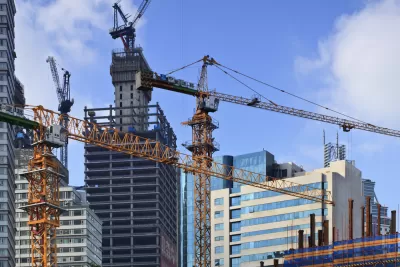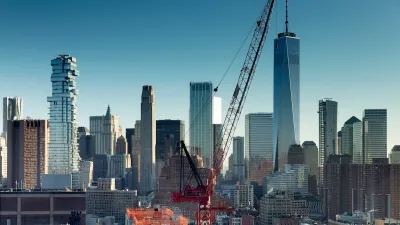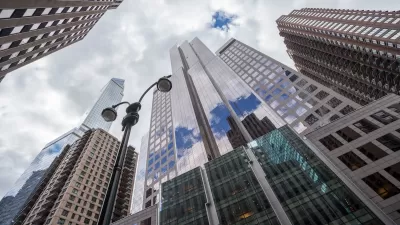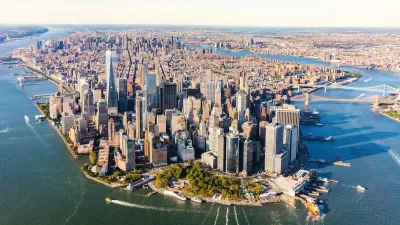Contrary to popular myth, New York is not drowning in new housing.

One common argument about building new housing is as follows: New York City built a ton of new housing and yet rents continue to rise. So If my city builds new housing, rents will continue to rise.
This claim has a tiny grain of truth: obviously, some housing units were built in New York over the past decade or so. But this fact proves nothing, because there is a large difference between "some new housing units" and "enough new housing units to meet demand." For example, if a city generates 10,000 new jobs per year but allows only one four-bedroom house to be built, obviously demand will have increased far more rapidly than supply, which means that prices are likely to rise.
Has New York built enough new housing? There are a few ways to measure New York’s housing supply growth or lack thereof. One is to compare New York's supply growth to that of earlier decades. New York's housing supply did grow in the 2010s, but not by very much compared to the city’s most productive decades. According to the city's rent guidelines board [PDF], just over 60,000 housing units were built in 1963 (the first year listed in the board’s most recent report). In 2018, 26,992 units were completed—more than in any year of the 21st century, but far below early 1960s levels. One might think that the city’s slowdown in building is because the outer boroughs are "built out." But in fact, early 1960s construction was much more likely to be in Manhattan than construction today. In 1963, 19,398 out of 60,031 units (or roughly 32 percent) were in Manhattan. In 2018, 5672 out of 26,992 units (or roughly 21 percent) were in Manhattan. In other words, New York City allows far less housing than in the 1960s.
Another way of looking at the problem is to compare New York to other American cities. According to the American Community Survey, only 1.7 percent of all New York housing units were built after 2010.* By contrast, in cheaper cities, there is more new housing. For example, 4.2 percent of all housing in the city of Dallas was built after 2010, as well as 4.9 percent in Houston, 4.6 percent in Atlanta, and 5 percent in Tampa. Even some high-cost cities have more new housing than New York—for example, 4.4 percent of all housing in Washington was built after 2010, and 3.2 percent of Portland’s housing. To make matters worse, New York's suburbs are also not allowing much housing. For example, in Long Island's Suffolk County, only 1 percent of housing units were built after 2010. By contrast, in Collin County (a suburb of Dallas), 10 percent of units were built after 2010.
Of course, any discussion of supply is incomplete without a discussion of demand. My city's population growth has not been enormous over the 2010s (from 8.1 million to 8.3 million). But this number excludes people frozen out of the city by high housing costs, and thus underestimates demand in a high-cost city. Another way of looking at demand is to look at the labor force (including unemployed New Yorkers). At a minimum, we know that the number of jobs in New York City grew from 3.7 million in 2010 to 4.6 million in 2018—almost a 25 percent increase.**
In sum, New York City’s housing stock actually grew (a) by less than in the 1960s; (b) by less than in many other cities; and c) by less than is actually needed to meet demand. This hardly constitutes a "building boom."
Why, then, are there newspaper headlines to the contrary? First, anti-housing activists have a strong incentive to stir up alarm about new towers, in order to stir up public panic. Second, some of the new housing consists of highly visible buildings in touristy places—such as the Hudson Yards towers on the West Side of midtown. Someone noticing those buildings might easily think that the city is being overwhelmed by new luxury high-rises—but this would be wrong, because that person would not notice all the buildings that are not built elsewhere in the city.
*I note that the newest ACS data shows that 59,296 units were built after 2010—far less than the rent guidelines board data suggests. I do not understand why this difference exists; however, I suspect that whatever causes this gap applies to other cities as well, and thus does not affect the reliability of the data.
**I say "at a minimum" because some people frozen out of the city by high housing costs might have actually created new jobs had they stayed in New York, rather than merely displacing another New Yorker from a job. It could be argued that this job growth reflects economic recovery more than it reflects population growth. However, the pre-recession employment peak was just over 3.8 million. It seems to me that if the pre-recession employment was closer to the current number, this number would be higher

Study: Maui’s Plan to Convert Vacation Rentals to Long-Term Housing Could Cause Nearly $1 Billion Economic Loss
The plan would reduce visitor accommodation by 25,% resulting in 1,900 jobs lost.

North Texas Transit Leaders Tout Benefits of TOD for Growing Region
At a summit focused on transit-oriented development, policymakers discussed how North Texas’ expanded light rail system can serve as a tool for economic growth.

Using Old Oil and Gas Wells for Green Energy Storage
Penn State researchers have found that repurposing abandoned oil and gas wells for geothermal-assisted compressed-air energy storage can boost efficiency, reduce environmental risks, and support clean energy and job transitions.

Santa Barbara Could Build Housing on County Land
County supervisors moved forward a proposal to build workforce housing on two county-owned parcels.

San Mateo Formally Opposes Freeway Project
The city council will send a letter to Caltrans urging the agency to reconsider a plan to expand the 101 through the city of San Mateo.

A Bronx Community Fights to Have its Voice Heard
After organizing and giving input for decades, the community around the Kingsbridge Armory might actually see it redeveloped — and they want to continue to have a say in how it goes.
Urban Design for Planners 1: Software Tools
This six-course series explores essential urban design concepts using open source software and equips planners with the tools they need to participate fully in the urban design process.
Planning for Universal Design
Learn the tools for implementing Universal Design in planning regulations.
Ascent Environmental
Borough of Carlisle
Institute for Housing and Urban Development Studies (IHS)
City of Grandview
Harvard GSD Executive Education
Toledo-Lucas County Plan Commissions
Salt Lake City
NYU Wagner Graduate School of Public Service






























